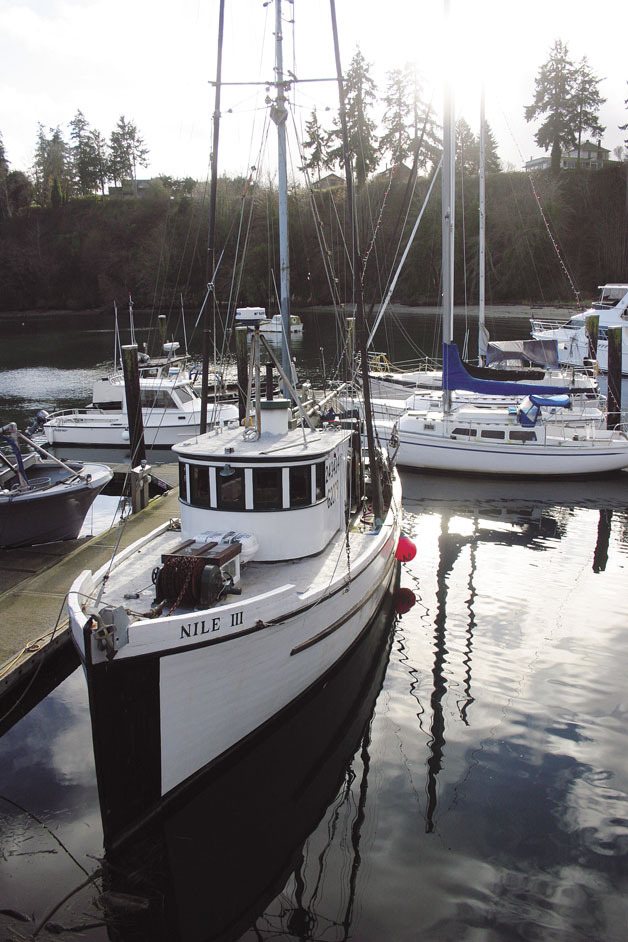Like battling a rip tide, Port of South Whidbey officials are trying to keep their Langley Marina expansion project buoyant in a foundering economy.
“It’s all about timing — permits, schedules and money,” Port Commissioner Geoff Tapert said Thursday.
“Right now, the estimated cost is higher than the funding we’ve identified for sure,” added port manager Ed Field. “But there’s still a lot of grant money out there.”
At a special workshop Wednesday, commissioners directed port staff to investigate the feasibility of scaling back phase one of the project, which would make permanent a 400-foot breakwater, install a 180-foot connector to get to it and build a 375-foot breakwater on the northeast side of the harbor to form a perimeter.
Depending on successful grant applications, the first phase of the project could go to bid in April, with construction in the latter part of 2011 and the first part of 2012, officials have said.
The total project, years from completion, would be a refiguring and expansion of the small-boat harbor to include an increase of the existing 38 boat slips to about 130 — most of them deep moorage — the removal of the existing dilapidated and abandoned wharf and the removal of a submerged pile of old tires, and eelgrass recovery and general improvement of the marine ecosystem.
The old wharf and its 83 creosoted pilings would be removed as part of phase one. The tires, a popular attraction of scuba divers at the marina because of the underwater habitats they have formed, would be removed in the second phase.
“We’re looking at options, but haven’t made a decision to go there yet,” Tapert said, noting that a change in plans could jeopardize the awarding of permits that the port already has applied for.
“First, we need to get the permits,” he said. “Once we have them, and know about our grant applications, we’ll have a much better picture.”
The first phase of the project is estimated to cost about $5.4 million, according to preliminary design figures provided by consultants Reid Middleton of Everett.
The port has in the bank a $1.2 million grant from sales-tax revenue under the county’s Rural County Economic Development Fund, and is awaiting word on two other grants totaling about $2.9 million, Field said Thursday.
The port is seeking a $1.5 million federal Boating Infrastructure Grant and about $1.4 million from a $2.4 million federal grant from the Department of Homeland Security applied for jointly by the port, the Island County Sheriff’s Office and Island County Fire District 3, Field said.
He said a decision on the remaining two grants is expected early next year. Meanwhile, port staff continues to look for more funds while considering alternatives, in case they may be required.
“This is all very preliminary,” Field said. “There are a couple of smaller grants we’re chasing, but it’s really hard to predict in the economic climate right now.”
Tapert said another funding avenue might be general obligation bonds that the port would repay over 20 years with revenue generated by the marina.
“Everything’s very tight, especially if one of the grants doesn’t come through,” he said. “That’s why we’re looking at options.”
There are also some environmental concerns in phase one that may need closer attention, Tapert said.
One of those is how to protect the marina from high winds and waves from the east during construction of the breakwater.
“It comes down to risk management,” Tapert said. “The commissioners would like to see that more protected.”
Another concern is the type of hydraulic hammer used in construction. The port is seeking a permit for a vibrating hammer to drive piles, but there’s a chance a traditional impact hammer might be required in difficult areas because of its data-collecting capabilities, Field said.
An impact hammer, however, would mean a different type of permit, which would take another six months or a year to obtain, he said. A marine mammal protection plan also would be required.
Port commissioners directed staff to determine if the port should go ahead and apply for another permit, so as not to disrupt the construction schedule if it turns out an impact hammer is needed, Field said.
The port took over ownership of the marina property in 2009 after lengthy negotiations with the marina’s previous owner, the city of Langley. The port already has made improvements, including refurbishing a small park onshore, and has hired a harbormaster to oversee day-to-day operations.
Port officials say expanding the marina will increase economic development in the South End, but voters rejected the last ballot proposal to fund a major marina makeover.
“We’re just plugging along,” Tapert said. “It’s frustrating. We need to work within our means and get something going, but it’s a complicated project.”
Field said staff will report on possible options to the marina plan at the commissioners’ next meeting, and the discussion likely will continue into the January meeting.
The commission meets at 7:30 p.m. Tuesday, Dec. 14 in the meeting room of the South Whidbey Parks & Rec District office at 5475 Maxwelton Road.



